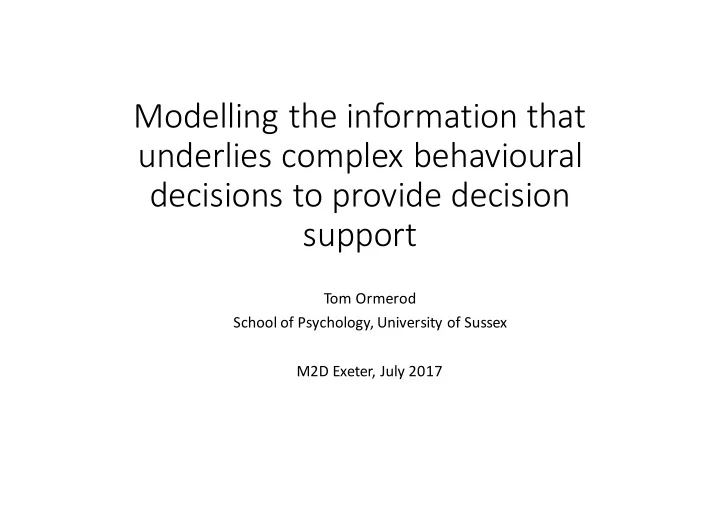

Modelling the information that underlies complex behavioural decisions to provide decision support Tom Ormerod School of Psychology, University of Sussex M2D Exeter, July 2017
Complex behavioural decisions: domain examples I. With the fall of IS in Mosul, Security and Intelligence agencies are faced with a challenge: How to decide if an individual is a refugee or insurgent? A task of investigative interviewing II. The UN is currently debating how best to empower women in developing countries. One model is the “chicken fund” approach used by NGOs such as the Gates Foundation. Should worldwide efforts focus on this or alternative approaches? A task of investment planning
Overview • Psychological models of decisions vs. of decision-making • Exploring the information that informs decisions • Modelling the role of information types in human decision-making • The potential of Interactive Activation Models for supporting decision-making
Modelling decisions vs. decision-making • Psychological models of decision-making use three types of information • Structural (e.g., formal logic – Piaget/Rips/Braine) • Semantic (e.g., mental models – Johnson-Laird) • Statistical (e.g., Bayes – Oaksford & Chater) • Information is used to make decisions via • Conscious procedures (e.g., GPS – Newell & Simon; ACTR – Anderson) • Unconscious activation (e.g., Fast & frugal heuristics – Gigerenzer) • Decisions are influenced by • Cognitive limitations (e.g., working memory) • External constraints/practices/structures (e.g., task rules; representation modality) • Pragmatics (e.g., resource limitations)
Information types: Investigative interviewing • Types of information • Structural (e.g., “If injured but no malnutrition, then treat as insurgent risk”) • Semantic (e.g., “Of four possible outcomes [insurgent/refugee; threat/benign], conditions rule out insurgent+benign”) • Statistical (e.g., “Typically, insurgents have characteristics that include….”) • Information use: • Conscious procedures (e.g., training in specific interview procedures) • Unconscious activation (e.g., gender/age stereotyping) • Decisions influenced by • Cognitive limitations (e.g., volume/complexity of alternative techniques) • External constraints (e.g., interview location / language) • Pragmatics (e.g., volume of refugees / political & organisational influences)
Example: Choosing the right investigative interviewing method • Three models of interviewer-interviewee interaction • Taylor’s Cylinder model • Alison’s Wheels model • Meissner and Klein’s Binocular model • Each model has empirical support and makes clear recommendations • Choice between models yields • Some complementarity • Some contradiction
Interactive activation models (IAMs) • IAMs are • Connectionist networks linking input/hidden/output layers • Used to model cognitive decision-making/phenomena • Featural rather than factorial representation (for modelling concept overlap) • Allow interactive (non-additive) activation • McClelland & Rumelhart’s (1998) word recognition model • E.g., Misspelling “friend as “freind” • “James and Tom had been freinds since childhood” vs. • “The criminals had been freinds since childhood”
Building Interview-IAM • Simbrain • Third-party environment for cognitive modelling • Structure of the network • Layers /nodes • ”Input” • Interviewee (characteristics – age, gender, experience, ethnicity, etc) • Interviewer / interpreter / intermediary/technique…. • Context” • Political/legislative context • Crime type / delay • “Output” • Outcome [no comment --> info gathering --> triage --> persuasion --> confession (true/false)] • Links • Initially – effect sizes from research (‘quality assured’ by the HIG investigative interviewing group https://www.fbi.gov/file-repository/hig-report-august-2016.pdf/view) • Potential – statistical, semantic and structural connectives
“Input” Interviewer Presence of experience age gender Interviewee intermediary ethnicity language Interview Interview TUE REID CCE technique SUE MCI “Outcome” +ve Triage Confession Quality Information Detect -ve gathering deception “Context” Political Crime type Time since imperative incident Criminal justice system
Objectives for Interview-IAM • Narrative • a descriptive visualisation of the space of concerns that impact interviewing • Coherence • a testbed for integrating and assessing alternative findings and theories of interviewing • Prediction • a resource for developing and testing new research predictions (e.g., “How will cultural differences impact the use of the Wheel model”?) • item-specific predictions (e.g., “What is the best interviewing approach to use with an insurgent in their own home”?). • Discovery • what gaps in interviewing research make the most difference to interview outcomes; • Communication • IAM-i as an advisory system allowing practitioners to access context-specific best practice
Recommend
More recommend